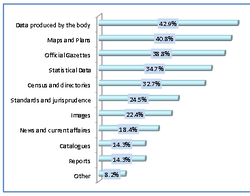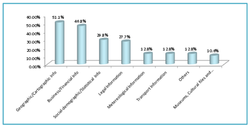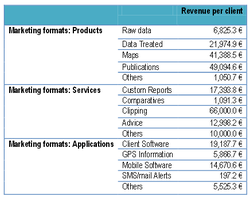Warning:
This wiki has been archived and is now read-only.
Best Practices/Infomediary Sector Characteristics
Contents
Title of the Best Practice: Infomediary Sector Characteristics
Outline of the best practice
The Spanish companies that create applications, products or value added services for third parties, from public sector information are studied periodically to better know their necessities in order to adapt the public sector information offer. Hereinafter we will call this set of companies: the infomediary sector.
Management summary
Challenge
- Discovering the main features of infomediary companies and their offered products and services which constitute the key agent in the reutilization process.
- Delineating the main characteristics of the primary information supply, which constitute the raw material from which the products and services are generated.
- Learning about the market and the demand for applications, products and services
- Obtaining some proposals for improvement
Solution.
The study provides and analyzes the key elements that define the infomediary sector in Spain, a sector made up of companies that produce products and / or services for sale to third parties from the public sector information; considering both companies they have been created for this purpose as those having an area and / or specific department dedicated to the creation and marketing of new products and / or services based on public sector information services.
Inside of this sector the general profile of the infomediary companies would be as the small companies (maximum 20 highly qualified employers). These companies have been established by self-employed workers with an extensive experience about information reuse. This type of activity was combined with the infomediary activity with other market segments generating products or services associated to specific sector information that were subsequently put on the market. The main information scope is: Geographic; Cartographic information; Business-Financial information; Social-demographic / Statistical information and Legal information. This does not means that they are isolated sectors. There are a lot of companies which share and use information from several contexts to generate services based on those combined informations to get a better added value to their reuse activity.
INFOMEDIARY INDUSTRY
- Over the 80% of Spanish infomediary companies are older than 5 years old.
- Proportion of employees dedicated to reuse according to the company size
- The estimated turnover directly associated with the infomediary activity is about 500M€ a year. Infomediary activity has grown or at least has been remained in the same figures as the previous year despite economical crisis in Spain.
- Infomediary sector generates approximately 4,500 to 5,500 jobs, mostly linked to ICT: analysis, processing and presentation of information.
- 85% of reused information is related to: Business, Economic, Geographic, Cartographic, Social-demographic, Statistical and Legal fields.
- The reused information comes mainly from Spanish Public Administrations. Moreover, half of the companies also reused international information.
- 94% of companies use online systems as channel to access the primary information. Looking into this 94%, over 90% of companies have accessed via web or directly to the information of each agency. Over 45% have accessed to the re-use specific portals created by public administrations. There is a 15% that have obtained the information from reusing companies.
- Original formats of the information being accessed for reuse are:
PRODUCTS, SERVICES AND APPLICATIONS OFFERED FROM REUSED INFORMATION
Infomediary companies have gathered public information to analyse it afterwards in order to get an added value to the use on their different typologies (products, maps, transformed data, raw data or published documents); services (by means of tailor made reports, assessment or comparative analysis); or applications (specific client applications development, software for mobile devices, information for GPS or SMS Alerts). Internet is the main source to carry out their activity: websites, emails or FTP files to distribute their products. So much so that the 98% of the companies use an electronic format and mainly the PDF format for the products/services distribution. (PDF with a 64% is the most popular format used for distribution of their products or services. 53% HTML, and 34% XML formats)
- Weight of the different types of information offered by reuse companies
- Consumers of products and services developed are: other companies and freelancers and administrations (cadastral information). Most are domestic consumers, but also has consumers in the EU and outside the EU.
- Almost all companies have customers in Spain. There is already a third of the infomediary companies that have customers abroad mainly in countries of the European Union. Out of EU we found just 25% have clients in other international geographical areas
MARKETING MODELS AND REVENUE
The main customers of the infomediary sector are essentially other companies (75.5%) with a couple of considerations. Firstly the Administration itself becomes an important customer in the industry (two out of three infomediary companies contracts with other administrations for the provision of services) and also third part of the sector has the universities as clients. From a territorial context point of view of the business, the Spanish market is essentially the one where the activity is made on although there is over than a 30% of the companies with clients in the rest of EU or almost a 25% with clients from overseas (not in EU). There are a lot of free incoming models co-living together in this market with other payment models. Free incoming models are used for more simple products/services or even the proper public information. Payment models are made for more specific products/services (pay per work or report) moreover some subscriptions methods.
- Products: Processed data is the major product offered followed by mapping and charting. More than 25% of companies, market the raw data of the Administration doing only an identification and collection activity to obtain their products. Publications are obtained from business or economy, legal, meteorological and transport information and mail is the channel preferred to distribute them.
- Services: Custom reports service are mainly offered by mail and Advising services are offered by messaging. Comparative reports are offered by companies that market services based on business-economic or demographic-statistical information. Companies that offer clipping are selling in this format only Cartographic-Geographic information.
- Applications: Client software format is used to provide Transport information; it is used by all of the companies that offer GPS or Geographic-Cartographic information. Mobile software is used to provide social-demographical and statistic information. And SMS or email alerts are used to provide the business or financial information
The value chain of the infomediary companies is as follows: Information of public bodies is obtained, a process of adding value leading to applications, products or services and the results obtained are ready to market. To set up a marketing model and revenue, it has to be considered that not all areas of public information allow adding the same level of value. In some cases, the added value is given only for classification and integration into search systems. In other cases more general or complex services or diverse products can be obtained depending on the information as is the case of geographic or cartographic information which can be transformed into different business models
Two models of business strategy are distinguished. The larger companies opt for a combination of business strategies "classic" with a network of geographically distributed sales, participation in fairs and event marketing, in addition to digital marketing strategies: Ecommerce, SEO / SEM positioning, web redirection. Smaller companies make smaller investments in marketing based on the optimization of online searches through SEO search engine optimization techniques and personal recommendations (viral marketing). Within the revenue models or business models there are two types:
- Free models (free unrestricted, by key, free with advertisement).
- Payment models (Pay per access, use, work performed; Pay per linear subscription or subscription with modalities depending on access, information accessed or information use).
- Best Practice Identification
Why is this a Best Practice? What's the impact of the Best Practice?
- It allows fulfilling the objectives of the directive Reuse and deepening the progress of the information society
- Fosters the development of new digital products and services, thereby stimulating economic and business activity and ultimately providing value for society as a whole.
- It helps to accomplish PSI Directive to each entity of its duty to publish public data and make that data available for reuse, adapting the offer to the private sector demand.
- It enables the existence of a global scenario that fosters the extraction of general conclusions and a general overview of the PSI situation in Spain, facilitating the use of this information to extract meaningful and actionable knowledge regarding the open data landscape
Link to the PSI Directive
(Please use one or more of the categories listed on the last page of this document, as many as relevant)
- Policies and legislation (legal requirements, licenses etc..)/ Licensing of information/data and metadata
- Dataset criteria and priorities and value and scope w.r.t. datasets
- Charging issues and proposals
- Organisational structures and skills
- Encouraging (commercial) re-use
- Data quality issues and solutions / Quality assurance, feedback channels and evaluation
- Selection of information/data to be published according to various criteria
- Data discoverability
Why is there a need for this Best Practice?
- To foster job creation in the infomediary sector
- To get the most out of scarce public resources that are available in our country
- To increase reuse in Spain, by the private and also by the public sectors
- To focus the government agencies efforts on offering the relevant information to the infomediary sector
- To improve available datasets formats, the information quality and its accessibility.
- To promote better national regulations on PSI
- To enhance coordination between public and private sector in PSI reuse
- What do you need for this Best Practice?
- A high-level mandate to endorse the study.
- Identify companies that make up the infomediary sector.
- Design and conduct a survey to find the necessary aspects.
- Collaborate with reuse PSI industry business associations
- Apply the lessons learned from the study results
- Periodically repeat the survey to measure the progress made
- Applicability by other member states?
- Directly applicable to any EU country because the study is not very expensive
- It would be desirable to dispose a study with a uniform methodology and common indicators to better understand the infomediary sector at European level.
- Contact info - record of the person to be contacted for additional information or advice.
- soporte@datos.gob.es
- http://administracionelectronica.gob.es/general/verContacto.htm
- Study June 2011 edition (in Spanish)
- http://www.ontsi.red.es/ontsi/sites/default/files/1308555551216.pdf
- Study July 2012 edition, Executive summary (in English)
- http://www.ontsi.red.es/ontsi/sites/default/files/121001_red_007_final_report_2012_edition__vf_en_1.pdf
- Study 2014 edition, Executive summary (in English)
- http://www.ontsi.red.es/ontsi/sites/default/files/executive_summary_public_infomediary_sector_2014.pdf (this edition has been published in march 2015)



